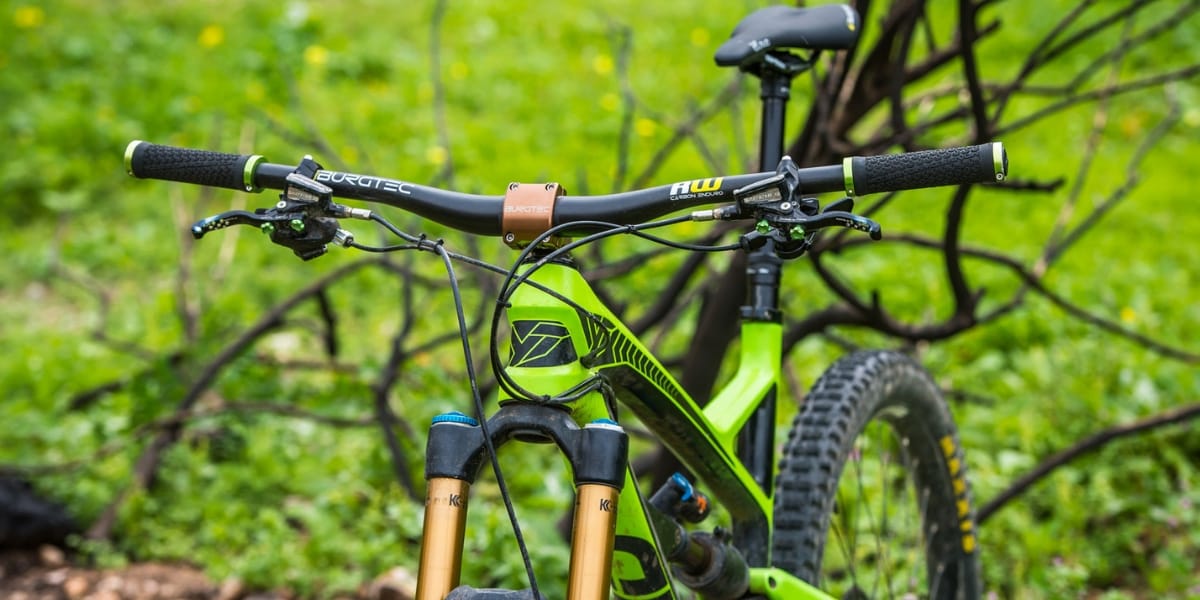
Choosing the Right Handlebar (Handlebar) for Better Mountain Bike Handling
An essential accessory to control your bike, handlebars (or handlebars) come in many different shapes and have several characteristics to consider when handling without any unpleasant surprises.
Hangers come in different diameters, lengths, shapes and are made from different materials, most often aluminum or carbon. Aluminum handlebars are usually the cheapest, but they are also the heaviest. These different materials have characteristics specific to each of them, so it is difficult to obtain empirical data. On the other hand, there are certain parameters to consider when it comes to geometry.
This is why, when examining the rudder geometry, you must take into account several values, including "lift", "sweep" ("lift up" and "reverse"), diameter. and width (length).
Sunrise"
The "rise" is basically the height difference between the center of the pipe where it attaches to the stem and the bottom of the end just after the taper and transition curve.
MTB handlebars typically have a "lift" from 0 ("flat bar") to 100 mm (4 inches).
Handlebars with 100mm lift are not very common anymore, and nowadays high lift bars are typically 40 to 50mm (1,5-2 inches).
"Lift" affects the position of the pilot. If the stance feels too low (for example, for a taller rider), a higher "lift" can help you get into a more comfortable stance. It is also preferable to use a handlebar with a higher "lift" rather than adding spacers (or "spacer") under the stem to raise it to accommodate a tall rider, because this will have less of a negative impact on handling. ...
A "lift" bar will be slightly more flexible than a straight bar, provided both bars are made of the same material and have the same diameter and width. This is explained by the fact that in absolute length (if you turn it into a straight tube) the "lift" rudder will be longer than its "flat rod".
Flat handlebars are usually popular on XC bikes, while "up" bars are used on downhill-oriented bikes. Because downhill bikes are optimized for downhill gradients, the higher incline keeps the rider's head and torso slightly higher for better control.
"Lift" will also slightly affect the weight distribution on the bike. While a flat handlebar increases the load on the front wheel, improving the ability to climb, a bar with a higher "lift" straightens the driver and shifts the center of gravity back, returning position more efficiently on descents.
"Rise"
"Up" corresponds to the vertical tilt of the steering wheel at the level of the handles. Swipe up affects the overall "lift" of the steering wheel, but it is a measure designed primarily for driver comfort than anything else. Most rudders have an upward steering angle of 4 ° to 6 °. This angle is closest to the neutral wrist position for most people.
Reverse move
The "swing back" corresponds to the angle at which the steering wheel returns to the driver.
This angle can vary from 0 ° to 12 °. Again, "reverse" refers to the rider's hand comfort and preference over all other performance considerations. Most standard bikes have a 9 ° rear handlebar. This means that the tips of the handlebars come back a little, which allows a longer or shorter stem to be used as the overall reach is good. Some MTB teams have experimented with a 12 ° reverse handlebar as it allowed them to use a wider handlebar without putting additional strain on their shoulders and arms.
If you place your hand in front of you, see how your hand (fingers closed) is naturally positioned. You will see that your forearm angle will not be 90 degrees. The reverse steering design essentially attempts to mimic this natural hand position when holding the wheel. The distance between the handlebars and your body determines the angle of attack of your wrists on the handlebars. You should also consider the width. The more your hands are brought together (short handlebars), the more their angle of inclination will be, and, conversely, the more they are separated, the more pronounced the angle of the wrist will be. Therefore, it is important to consider the width of the shoulders when choosing the type of handlebars in order to obtain a natural riding position.
Therefore, handlebar retraction should be considered when placing the cyclist.
For example, if you have a 720mm handlebar with a 9 ° back tilt and you change to a new handlebar of the same width, but with a 6 ° back turn, then the handlebars will be wider because the limbs will be less tilted towards the back and then the position of your wrists will change. ... This can be corrected by choosing a shorter stem. Thus, the backstroke can be directly related to the length of your rod during your positioning.
Diameter
The steering wheel can be of several diameters. Today there are two main diameters: 31,8 mm (the most common) and 35 mm (the fastest emerging). These numbers represent the diameter of the center bar to which the stem is attached. Larger diameter bars are generally stronger and stiffer. The large diameter also allows for a larger stem contact surface, thereby reducing the required clamping pressure. This characteristic is especially important for carbon handlebars.

Width Length)
Handlebar width is the element that has the most direct impact on the ride. This is the total distance measured from right to left from the ends. Today's handlebars range from 710mm to 800mm. The wide handlebar reduces steering sensitivity and improves stability when cornering at high speeds. It also makes it easier to breathe when lifting. A wider handlebar isn't necessarily ideal, you have to consider your comfort, position and stem length.
An easy way to find out your natural width is to take a “push-up” position on the floor and measure the distance between the tips of your two hands. This method gives you a good starting point for choosing the right width handlebar for your size.
Do your wrists still hurt?
Muscle and joint pain too often interferes with pleasure. To correct position and restore comfort, the handles have been designed with biomechanical support in mind that is clearly superior to conventional handles.

